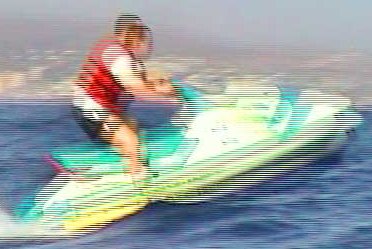Deinterlacing

What is deinterlacing?
Deinterlacing is the
process of converting interlaced video (a
sequence of fields) into a non-interlaced form (a sequence of frames).
This is a fundamentally impossible process
that must always produce some image degradation, since it ideally
requires 'temporal interpolation' which involves guessing the movement
of every object in the image and applying motion correction to every
object.
In a CRT, interlaced display draws only half of the lines on the screen for each frame (alternately drawing the odd and even lines for each frame). This reduces flicker by taking advantage of the persistence of vision effect, producing a refresh rate of double the frame rate without the overhead of either transmitting each frame twice or holding it in a buffer so it can be redrawn.
When displaying video on a display that can support a high enough
refresh rate such that flicker isn't perceivable, interlaced video can
be deinterlaced
for better viewing. When a display cannot interlace but must draw the
entire screen each time, the video must be deinterlaced before it can
be displayed. All current displays except for CRT
screens require deinterlace. Though in principle there is no reason why
LCD, DLP or Plasma displays should not display two fields sequentially,
the requirement that half of the pixels remain black would result in a
halving of brightness, even assuming that the response time of the
technology could be made fast enough.
Deinterlacing method used in DynTex
There are
various methods to deinterlace video, each producing different
artefacts. Artefacts
will always be present in deinterlaced video, as the process must
attempt to
combine two fields for simultaneous presentation. Any object that is
moving
will appear in different positions on the two fields, and simply
displaying
them overlaid results in a very objectionable 'comb-effect' on the moving
vertical edges. Methods often used for deinterlacing are weaving,
blending, line doubling, and some make use of motion
compensation.
There is no perfect way to interpolate images in time, unless
everything is
moving together, as in a panned image. It is particularly difficult
when it
comes to deinterlaced dynamic textures: usually they are not rigid
processes, and
texture information can be partly lost because of spatial
subsampling.
The original DynTex sequences are interlaced, in DV format. These raw sequences are provided, so that each DynTex user can perform his/her own deinterlacing method. Next to these, DynTex
also offers the sequences in deinterlaced form, based on a spatio-temporal median
filter
(see the Database
section). The spatio-temporal median filter is a non-linear
filter, and
is the extension of the spatial median filter to spatio-temporal
neighbourhoods.
The spatio-temporal filter offers a good compromise between
deinterlacing the
sequence and keeping the textural information.
Of course, feel free to
use your own deinterlacing method, and let us know if you have designed
a
suitable deinterlacing method for dynamic textures !

